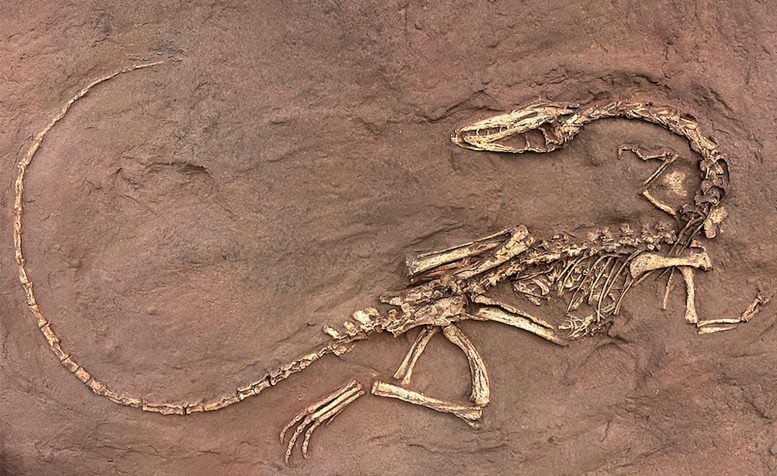New Discoveries Reveal Shocking Insights About the Catastrophic End-Triassic Mass Extinction

The early dinosaur Coelophysis bauri's skeleton from the Late Triassic indicates prolonged restructuring of Early Jurassic terrestrial ecosystems, which aligns with the diversification of dinosaurs. This information is credited to the Natural History Museum of Los Angeles County.
A USC Dornsife research team has unearthed revelations about the severe changes spurred by a rise in greenhouse gases and climbing temperatures. These changes resulted in a mass extinction event, which paved the way for the advent of Jurassic dinosaurs.
Research led by a team from the USC Dornsife College of Letters, Arts and Sciences has unveiled enlightening new knowledge about one of the most destructive events in Earth's history. Their discoveries not only augment our knowledge of the end-Triassic mass extinction but also provide vital lessons for tackling today's environment-related challenges.
About 200 million years ago, Earth underwent its fourth major mass extinction incident. Spurred by a sharp increase in greenhouse gases due to volcanic activity, this event resulted in swift global warming and a considerable shift in the planet's biosphere, which terminated the Triassic era and sparked the Jurassic era. Currently, many scientists hypothesize that Earth is experiencing another mass extinction primarily driven by similar climatic changes.
Earth scientists at USC Dornsife employed an innovation referred to as "ecospace framework" to study the effects of this extinction incident on both aquatic and land ecosystems. This method categorizes animals based on more than just their species, taking into account ecological roles and behaviors — from air or water predators to herb grazers and from ocean seabed invertebrates to soil-dwelling land animals.
Reconstructed data of a Late Triassic ecosystem from Ghost Ranch, New Mexico, was incorporated into the research team’s global ecological dataset. This comes from the published specimens and species preserved at Ghost Ranch. This information is credited to Viktor O. Leshyk from the Natural History Museum of Los Angeles County.
According to David Bottjer, an Earth sciences, biological sciences, and environmental studies professor at USC Dornsife and a study senior author, they sought to understand not just what species survived and what species didn't, but also how the roles different species played within the ecosystem altered. He added that this method allows them to comprehend the more extensive, interconnected ecological picture.
A collaborative study between students and faculty of USC Dornsife and the Natural History Museum of Los Angeles County was recently published in the journal Proceedings of the Royal Society B. This study discovered a notable difference in the impact on marine and terrestrial ecosystems. Even though both environments suffered substantially, the findings suggest terrestrial ecosystems bore a greater brunt and more prolonged instability.
In the oceans, nearly 71% of species categories, known as genera, disappeared. Yet, despite this massive loss, the overall marine ecosystems' structure demonstrated resilience. Predatory creatures like sharks, ammonites, and filter feeders like sponges, and brachiopods, despite being severely affected, recovered eventually.
Land ecosystems, on the other hand, faced a much dire scenario. A shocking 96% of terrestrial genera became extinct, radically redefining life on Earth. Large herbivores like early dinosaurs and varied small predators suffered major setbacks, with significant alterations in their populations and roles within ecosystems.
Alison Cribb, the study's co-lead author who earned her Ph.D. in geological sciences at USC Dornsife this year and currently at the University of Southampton in the U.K., said this contrast tells us about the different ecosystems' reaction to catastrophic events. She added, these findings raise vital questions about the connection between biodiversity and ecological resilience.
These findings spur more than mere historical curiosity. They carry essential implications for our existing environmental dilemma. Study co-lead author Kiersten Formoso, nearing the completion of her doctoral studies in vertebrate paleobiology at USC Dornsife and soon to join Rutgers University, said that understanding past mass extinctions aids in predicting and potentially mitigating impacts of current and future environmental crises.
The resemblances between the abrupt global warming of the end-Triassic and today's climate change are especially noticeable. Bottjer concluded, "We’re observing similar patterns now — swift climate change, a depletion of biodiversity. The knowledge of past ecosystem responses can contribute to our conservation endeavors today."
The research also provides a rare window into the world as it existed over 200 million years ago, he added. “It’s like a time machine, giving us a glimpse of life during a period of profound change.”
The study’s ecospace framework, with its focus on functional roles, offers a fresh perspective on ancient life, according to Frank Corsetti, professor of Earth sciences and chair of USC Dornsife’s Department of Earth Sciences. “It’s not just about identifying fossils,” he said. “It’s about piecing together the puzzle of ancient ecosystems and how they functioned.”
As they plan further research, the scientists aim to explore how different species and ecosystems recovered after the extinction, and how these ancient events can parallel current biodiversity loss due to climate change.
Future studies are also planned to examine changes in ecospace dynamics across other periods of profound environmental change in deep time.
“We’ve just scratched the surface,” said Cribb. “There’s so much more to learn about how life on Earth responds to extreme changes, and this new ecospace framework offers great potential for helping us do that.”
The study was conceived, and much of the work done, during the COVID-19 pandemic, when restrictions on many other types of research were in place, said Bottjer. “This produced unique conditions that fostered and led to the development and completion of this research involving individuals with expertise across a broad variety of paleobiological fields, from microbes to invertebrates to vertebrates, in marine and terrestrial environments, with everyone working together towards one goal,” he said.




